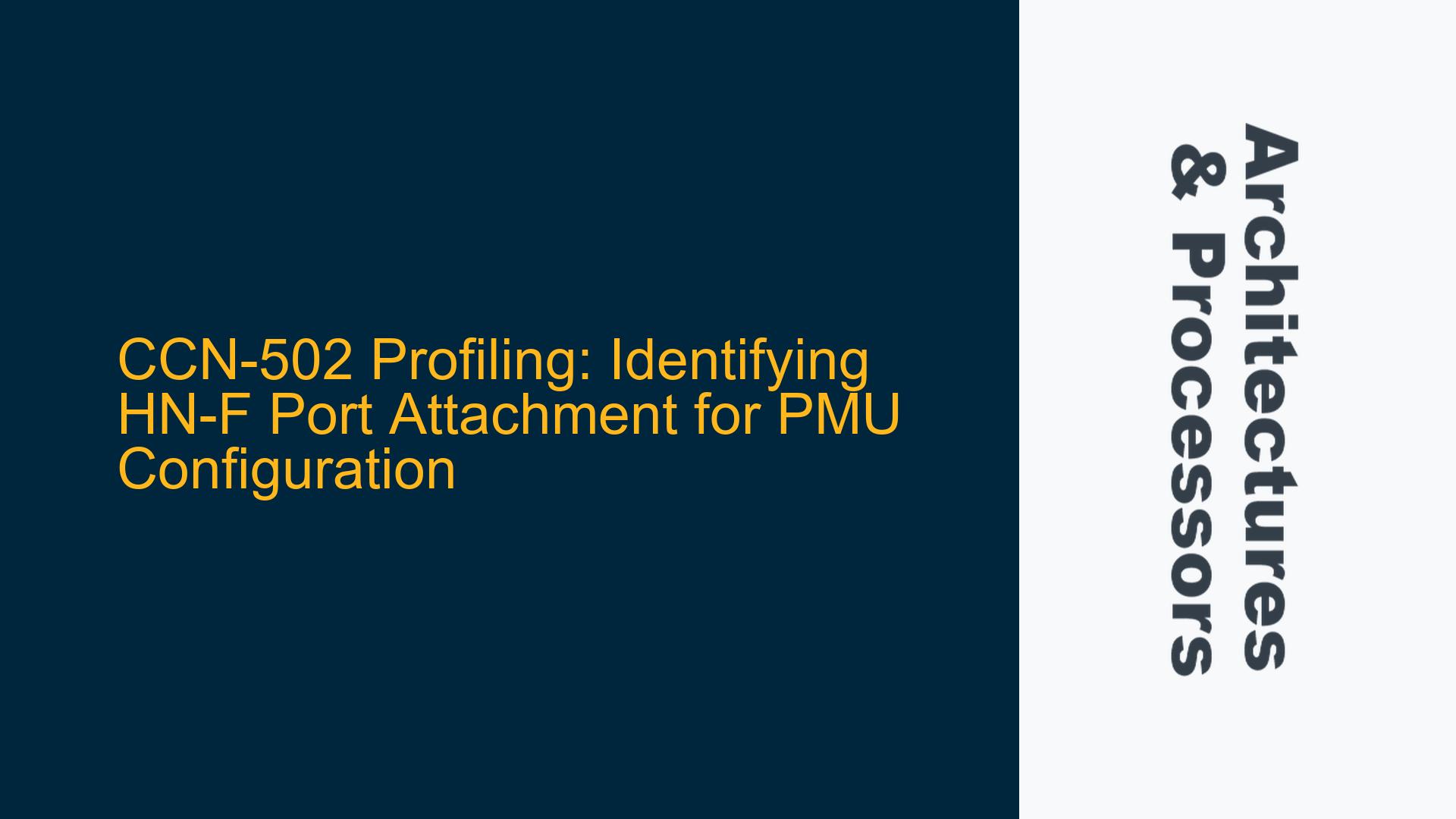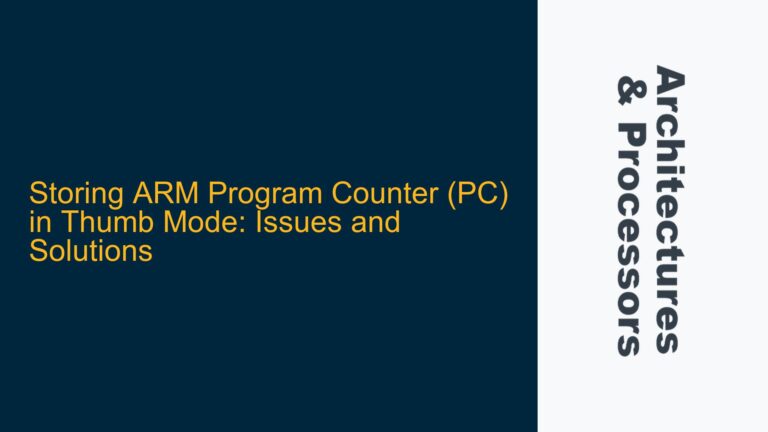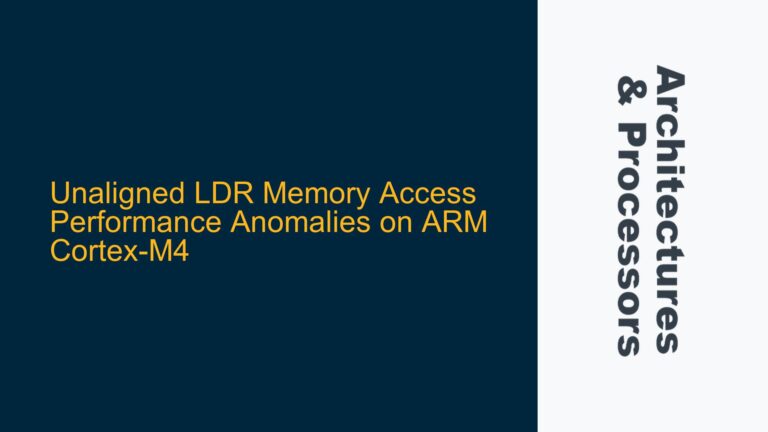Understanding HN-F Port Attachment in CCN-502 for PMU Event Selection
The CCN-502 interconnect is a critical component in ARM-based SoCs, enabling high-performance communication between various system components such as CPUs, GPUs, and memory controllers. One of the key features of the CCN-502 is its ability to profile system performance using Performance Monitoring Units (PMUs) and Debug Event Modules. However, configuring these PMUs requires a deep understanding of the interconnect topology, particularly the attachment of Home Nodes (HN-F) to Crosspoint (XP) ports. The challenge lies in determining whether a specific HN-F is attached as Device 0 or Device 1 on an XP, as this information is crucial for programming the dt_config register to transfer PMU events.
The dt_config register in the XP is used to configure which events are transferred from the HN-F to the XP for further processing. The encoding values in the dt_config register are specific to Device 0 and Device 1, meaning that the correct configuration depends on knowing the exact attachment of the HN-F to the XP. Without this information, the PMU events cannot be accurately captured, leading to incomplete or incorrect performance profiling.
The CCN-502 Technical Reference Manual (TRM) provides detailed information on the PMU and Debug Event Module, but it does not explicitly state how to determine whether an HN-F is attached as Device 0 or Device 1. This lack of clarity can lead to confusion and misconfiguration, especially when dealing with complex SoC designs where multiple HN-Fs and XPs are interconnected. The issue is further compounded by the absence of a read-only register that explicitly indicates the attachment status of an HN-F.
To address this challenge, it is essential to understand the underlying architecture of the CCN-502 interconnect, the role of HN-Fs and XPs, and the mechanisms by which PMU events are transferred and captured. This understanding will enable the correct configuration of the dt_config register and ensure accurate performance profiling.
Potential Causes of HN-F Port Attachment Ambiguity
The ambiguity in determining whether an HN-F is attached as Device 0 or Device 1 on an XP can be attributed to several factors. One of the primary causes is the lack of explicit documentation in the CCN-502 TRM regarding the mapping of HN-Fs to XPs. While the TRM provides detailed information on the PMU and Debug Event Module, it does not specify how to identify the attachment of an HN-F to an XP. This omission can lead to confusion, especially for engineers who are new to the CCN-502 architecture.
Another potential cause is the complexity of the CCN-502 interconnect topology. In a typical SoC design, multiple HN-Fs and XPs are interconnected in a mesh or ring topology, making it difficult to trace the exact attachment of each HN-F to an XP. This complexity is further exacerbated in large-scale SoCs where the number of HN-Fs and XPs can be significant. Without a clear understanding of the interconnect topology, it becomes challenging to determine the correct configuration for the dt_config register.
The absence of a read-only register that explicitly indicates the attachment status of an HN-F is another contributing factor. In many ARM-based SoCs, read-only registers are used to provide status information about various components, including the attachment of HN-Fs to XPs. However, in the case of the CCN-502, such a register is not available, making it difficult to determine the attachment status programmatically. This lack of a direct method to query the attachment status forces engineers to rely on indirect methods, such as analyzing the interconnect topology or using debug tools.
Additionally, the encoding values in the dt_config register are specific to Device 0 and Device 1, meaning that the correct configuration depends on knowing the exact attachment of the HN-F to the XP. If the attachment status is not known, the dt_config register may be misconfigured, leading to incorrect or incomplete PMU event capture. This misconfiguration can result in inaccurate performance profiling, which can have significant implications for system optimization and debugging.
Resolving HN-F Port Attachment Ambiguity Through Topology Analysis and Debug Tools
To resolve the ambiguity in determining whether an HN-F is attached as Device 0 or Device 1 on an XP, a systematic approach is required. This approach involves analyzing the CCN-502 interconnect topology, using debug tools to trace the attachment of HN-Fs to XPs, and verifying the configuration through simulation and testing.
The first step in resolving the ambiguity is to analyze the CCN-502 interconnect topology. This analysis involves understanding the layout of HN-Fs and XPs in the SoC and tracing the connections between them. In a typical CCN-502 design, HN-Fs are connected to XPs in a specific pattern, which can be determined from the SoC design documentation or by examining the RTL code. By mapping out the interconnect topology, it is possible to identify which HN-Fs are attached to which XPs and whether they are configured as Device 0 or Device 1.
Once the interconnect topology has been analyzed, the next step is to use debug tools to trace the attachment of HN-Fs to XPs. ARM provides a range of debug tools, such as the ARM DS-5 Development Studio, which can be used to probe the CCN-502 interconnect and capture information about the attachment of HN-Fs to XPs. These tools can provide detailed insights into the interconnect topology and help identify the attachment status of each HN-F. By using these tools, engineers can verify the attachment status and ensure that the dt_config register is configured correctly.
In addition to using debug tools, it is also important to verify the configuration through simulation and testing. This verification involves setting up a simulation environment that models the CCN-502 interconnect and the attached HN-Fs and XPs. By running simulations with different configurations, it is possible to observe the behavior of the PMU and Debug Event Module and verify that the dt_config register is correctly programmed. This simulation-based approach allows engineers to test different scenarios and ensure that the PMU events are accurately captured.
Finally, it is important to document the findings and share them with the design and verification teams. This documentation should include the interconnect topology, the attachment status of each HN-F, and the configuration of the dt_config register. By sharing this information, engineers can ensure that the PMU and Debug Event Module are correctly configured and that the performance profiling is accurate.
In conclusion, resolving the ambiguity in determining whether an HN-F is attached as Device 0 or Device 1 on an XP requires a systematic approach that involves analyzing the interconnect topology, using debug tools, and verifying the configuration through simulation and testing. By following this approach, engineers can ensure that the dt_config register is correctly programmed and that the PMU events are accurately captured, leading to accurate performance profiling and system optimization.






